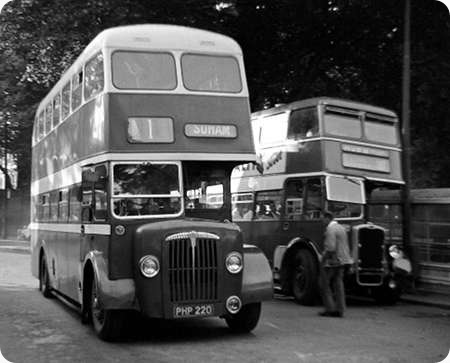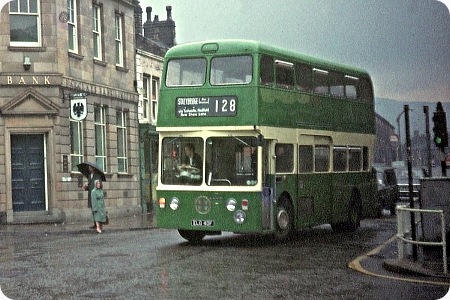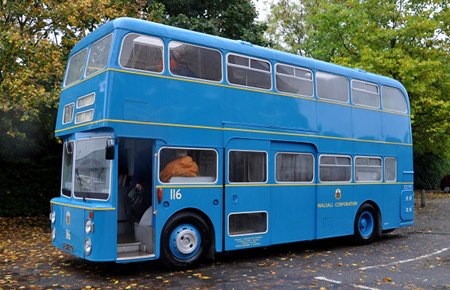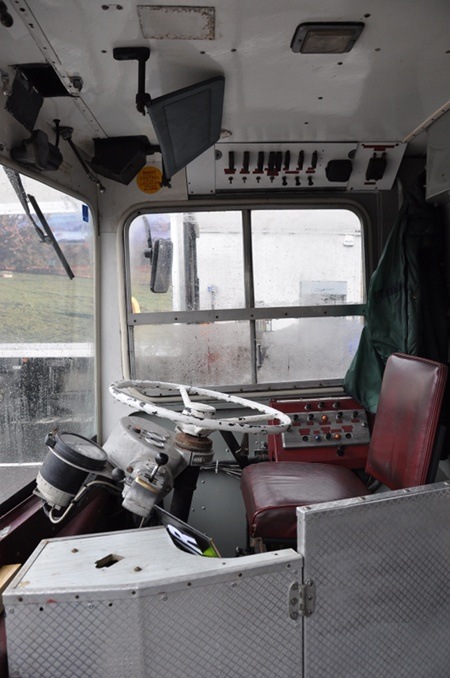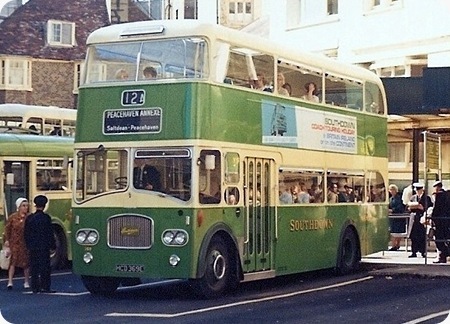
Copyright Diesel Dave
Southdown Motor Services Ltd
1967
Leyland Titan PD3/4
Northern Counties FH39/30F
The posting a little while ago of the Bradford Daimler CVG6 was a reminder that although both they and Leyland were then manufacturing rear-engined double decker chassis in large numbers, not all operators were yet willing to make the change to them. Southdown’s later Queen Marys are examples of some of Leyland’s last traditional front-engined vehicles.
Judging by the number of them that have been preserved, (many of them went on to have second lives with independents, of course), and by comments I’ve read, Queen Marys have a great number of fans. Not everyone liked them, however, and I’ve also heard some unflattering remarks about their appearance. Prior experience makes me reluctant to express my own views just yet!
Queen Marys, which Southdown bought in very large numbers, were pretty well standard fare when I joined as Traffic Superintendent, Brighton, but I never really got to drive them. A Maidstone & District District Superintendent who I respected and admired made a point of becoming familiar with all vehicles allocated to him, which struck me as an eminently sensible idea. It was quickly made clear to me, however, that at Southdown such a practice was regarded as ‘inappropriate’, so a trip to Devil’s Dyke and back was all I ever managed at the wheel.
The photo is of the final ‘Panoramic’ version of the Northern Counties bodywork, in which the cream paint is taken straight across the front rather than curving round the windscreen as it did in the more numerous earlier Queen Marys. Three years later, Southdown followed their eastern neighbour by changing to Fleetlines.
Photograph by Diesel Dave Copy contributed by Roy Burke
A full list of Titan codes can be seen here.
12/10/12 – 08:31
I have never understood the Queen Mary name for these. Only Southdown versions seem to have been given this name, while the PD3/MCW combination with Ribble was given the name Tank. Even ex-Southdown drivers of my acquaintance don’t seem to know the reasoning. Is it just an enthusiast nickname, like certain railway locomotives have unofficial names (Class 40 Whistler, Class 50 Hoover, etc)?
Of the bodies, I liked the "Panoramic" style the least, whether it was the Northern Counties on a PD3 or an Alexander on an Atlantean. Some Ribble Atlanteans, of similar vintage to this, had Northern Counties bodies with the same front dome. To me, it just doesn’t look right. Put "Panoramic" windows on a coach, however, and it’s a different story!
Pete Davies
12/10/12 – 15:32
I tend to agree with you on that point, Pete, I like the original version of these, and whilst I would say that the Alexander ‘Y’s look far better as a Panoramic, the double decker’s with the same front as the MCW clone just looked wrong, however, I quite liked the later Alexander D/D’s with the larger windows.
Ronnie Hoye
12/10/12 – 18:06
At the risk of making myself unpopular with all of this website’s southern readers, I never understood the popularity of this design – or for that matter the popularity of Southdown’s (to me rather "yucky") livery. Ribble’s PD3/MCCW FH72Fs were clearly better looking and the colour scheme suited them down to the ground. And this comes from a man who can barely look at a standard MCW Orion body without shaking his head. I never felt a similar affection for the PD3/Burlingham variant with the full-front, much preferring the Burlingham design as a half cab with the BMMO front as supplied to Scout.
As for the later "panoramic" version of the Southdown PD3/NCME (as shown above), perhaps it should be transferred to the Ugly Bus page before it gives us all nightmares. Some very unfortunate designs came out of Northern Counties in the latter half of the 1960s, making one wonder if personnel from Massey Bros had taken over the design team after the take-over of that company by NCME. Massey were renowned for their aesthetically challenged body styling – their lowbridge vehicles had a (thankfully) unique "stepped on by a giant" look while their single-deckers were hideous without fail. I look forward to opposing viewpoints!
Neville Mercer
12/10/12 – 18:14
I much preferred the earlier versions with single headlamps and the ‘conventional’ upper deck front dome. I thought the opening vent in the nearside front windscreen spoiled the design which was otherwise very well balanced. And of course the livery helped. Simple but very classy and also timeless. It would still look good on many of today’s modern buses.
Philip Halstead
13/10/12 – 07:00
Neville, you’re not upsetting me! My ancestry is Lancastrian, and my schooldays were spent in Lancaster itself and British West Bradford, though I was born in London. I’ve lived in and around Southampton for over 40 years now, and many of the contributions I’m planning reflect this.
So far as the livery is concerned, I have encountered a number of operators with what might best be described as pseudo-Southdown arrangements, Southern National before they succumbed to the "Barbie Doll" being the biggest example. Perhaps a darker green might have helped (but not NBC "LEAF"!)
Pete Davies
13/10/12 – 07:01
Calm down, calm down, Neville, it’s only a bus! To condemn the above bus to the Ugly Bus page, is extreme. And I feel that ones taste in buses, like anything else is hardly a North-South Divide’ thing. I’ll stand with Philip on my view on this vehicle. I certainly don’t feel that the Ribble version looked better, the Orion body was, as many Orion bodies were; less attractive and the livery blander, but not deserving of being condemned to the Ugly Bus page! (Of course, am I toning my real thoughts down, in the interest of your blood pressure!). We do agree about Massey bodywork, however, especially those with outrageously curved upper deck fronts.
Chris Hebbron
13/10/12 – 07:01
A piece of local folklore? The Southdown terminus in Southsea was at South Parade Pier. Drivers and conductors would gather to chat and smoke prior to their next departure on the promenade. Looking out to sea, one observed the Queen Mary (the liner!) passing through the Solent one day. ‘My that’s a big ship — big just like our new buses — they must be the "Queen Mary"s of the bus world,’ — or something like that. PS: I don’t believe a word of it!! However, opinion amongst ex-staff here in Portsmouth as to whether or not the term originated with employees, or is pure enthusiast is divided — so take your pick!
Philip Lamb
13/10/12 – 07:02
I feel that I must take issue with some of your contributors. Beauty is in the eye of the beholder and all that, but, to me, this is a pleasing design with a timeless, attractive livery.
I don’t think that the Queen Marys were universally popular with the staff. The drivers had a hot and noisy engine in the cab with them. The conductors had nowhere to stand, when passengers were boarding and alighting, as they funnelled past him (or her). Without a recess, he was simply ‘in their way’. And, I would have thought that the fitters would probably have preferred the easier access offered by an opening bonnet.
But for the passenger – heaven! Over the downs to Newhaven, Seaford, Beachy Head and Eastbourne. Those lovely big windows and sunny aspect through the Perspex roof panels.
Along the coast road to Worthing, Chichester and beyond. Looking out to sea from their own personal observatory. Or up through the Wealden countryside, over Crowborough Beacon to Royal Tunbridge Wells.
Bus travel at its best. Things were going to go downhill after this. Single deckers, then Leyland Nationals, harsh Bristol VRs with a thin skin and small windows. No thanks, a panoramic Queen Mary for me any day, thanks !
Peter Murnaghan
13/10/12 – 07:03
The problem with this design in my view (and I suspect in Southdown’s view at the time) is that it is a hybrid of two aesthetics. What they really wanted to do was to put a BET windscreen on it. They tried a couple of times, but it meant moving the radiator and that didn’t work too well. As long as the rad filler was in that position they had to use the throwback windscreens, which looked silly beneath the modern upper deck window. No doubt the change of livery was a failed attempt to disguise the fact.
As for Northern Counties post-Massey, there was definitely some Massey influence (and almost certainly some Massey parts) in certain designs, but not this one. Northern Counties’ idea of using the rear window of a BET single decker at the front of the upper deck was a straight copy of what Alexander had done using the Y type rear window. Unfortunately it didn’t fit so well, although it seemed to fit better on Southdown vehicles that anyone else’s – possibly because of deeper side windows.
Peter Williamson
13/10/12 – 10:38
OK. Gloves off. As Neville’s biggest fan: Don’t agree about Southdown livery but agree about Tanks. As a Roe man, I still think an Orion can look good in the appropriate livery, though. Suppose I do agree, as a Burlingham man, with the comments on full-frontal Ribbles. Have to defend Neville on the ugliness of Panoramic QMs – back to balance of design or lack of it – and certainly of Masseys. [See also Peter W’s comments.] …..but Peter M, you don’t need to take issue. As you say, beauty in the eye of the beholder. Friendly banter and tongue in cheek digs help liven us up here on OBP. Sometimes a knee jerk reaction needs further contemplation – even in a forum like this. So often we challenge comments and then on reflection see how true they are and that we probably actually agree with them.
David Oldfield
14/10/12 – 07:22
Ugliness is in the eye of the beholder. I never liked the Queen Marys or the Ribble equivalents. Disguising what was a chassis designed for half cabs was never a good idea and the blame goes back pre WW2 to Blackpool and others. Even some of the full front front engined singles looked poor. An honest half cab can’t be beaten.
But what do I know – I liked the Park Royal Renown. Big, brutish without the vices of the Park Royal Bridgemaster it plainly stated I’m a BUS. It looked good in North Western and King Alfred colours and when Crosville inherited theirs, the large amounts of solid green set off with black wheels looked very smart – possibly the best scheme ever applied until some idiot applied NBC logos and horrible grey wheels. See www.sct61.org.uk/nw964
Phil Blinkhorn
14/10/12 – 08:02
Phil, I’m with you all the way – especially re Renown.
David Oldfield
14/10/12 – 08:03
I, too, found the appearance of the "panoramic" version of the Southdown Queen Mary PD3/4s to be a curious hotchpotch of clashing features. The earlier style of Northern Counties FH39/30F bodies on these buses possessed classic lines, which, in my view anyway, were more aesthetically appealing than their Ribble MCW equivalents, but then I have never been a fan of the Orion body and its derivatives. To me, the Burlingham bodied version of the Ribble PD3 was much superior in appearance. London Country obtained examples of both the Southdown and Ribble PD3/Burlingham for training purposes, but the Southdown Queen Marys were subsequently used in service from Godstone garage on the long 409 route between Croydon and Forest Row, and on the interworked 411 between Croydon and Reigate. These ex Southdown machines were of the semi automatic PD3/5 type, of which Southdown bought a batch of 40 in 1961/62. They were not very successful, having particularly poor hill climbing ability, and they were soon relegated to the flatter services. Unfortunately, though I rode very often as a passenger on the Southdown Queen Marys, I never got to sample the performance of the three LCBS examples. Though they must have struggled on the stiff gradients around the Caterham Valley, and Redstone Hill, Redhill, they gave a year of faithful service on those routes. After the unsuccessful flirtation with the semi automatic PD3, Southdown reverted to the PD3/4 with clutch and synchromesh gearbox, but the Northern Counties bodies took different forms. In addition to the initial classic style, some were built with convertible open tops, and then came the somewhat odd "panoramic" version. The variations did not end there, because one of the earlier examples was rebuilt with a repositioned radiator as part of a prototype saloon heating system. The absence of a front mounted radiator allowed the fitment of a panoramic style windscreen, which looked decidedly incongruous on the otherwise standard body. This bus, No. 257, can be seen here:- www.sct61.org.uk
Here are some more pictures of Queen Marys.
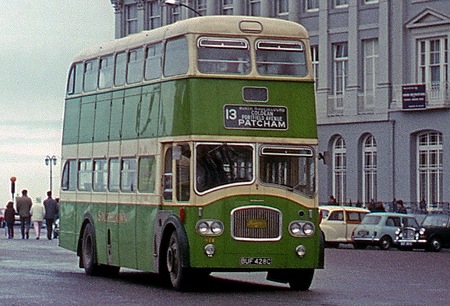
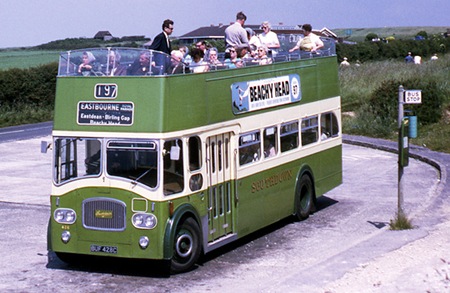
BUF 428C of 1965 is an example of the convertible open topper, distinguished by the slightly greater depth of panelling between decks – unlike its permanently roofed fellows, the front route number box is not located directly under the base of the windows. It is seen at Old Steine, Brighton, in winter garb, and again at Beachy Head in its summer form.
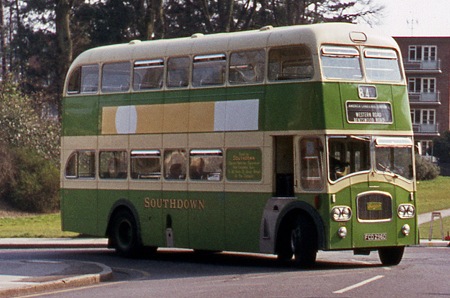
FCD 296D is a 1966 bus, and is seen in Haywards Heath.
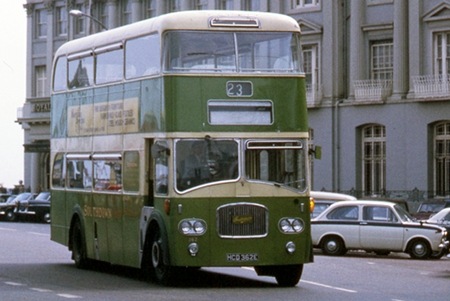
HCD 362E, also at Old Steine, is one of the panoramic buses delivered in 1967.
Roger Cox
14/10/12 – 10:33
The panoramic windowed body on these Titans was in many ways a front engined version of the panoramic bodywork supplied on rear engined chassis to Yorkshire Traction among others an example of which appears in the YTC section on this web site The bus with the curved windscreen looks to me for all the world like a Southdown NCME Leopard with an upper deck dumped on top! When one of the Southdowns appeared at the 1966 Earls Court show the only other front engined bus was an AEC Regent V for South Wales with a very traditional Willowbrook body A design that to my mind that has not dated as much as the Southdown one
However as a totally biased member of the Roe fan club to me the acme of traditional bus design was the 30 foot AEC Regent Vs bought by my beloved Leeds City Transport from 1962 to 1966!
Chris Hough
14/10/12 – 10:34
Thank you, gentlemen, for your comments, which I’ve read with much pleasure. When I joined Southdown, which I did with immense enthusiasm, I was very keen to compare their modern ‘traditional’ Leyland fleet with M&D, whose PD2s were all at least 14 years old, and whose Atlanteans were very expensive to buy, run and maintain. I was also interested to see what improvements Leyland had made to their front-engined chassis.
However, since Southdown didn’t think it necessary to give the likes of me access to management accounts, (or to any management or operational information for that matter), I was never able to make an operational evaluation. My very short driving experience was rather disappointing. As Peter M points out, these PD3s were pretty noisy in the cab, the full front reduced nearside visibility slightly, and they were not noticeably improved from the PD2s I already knew. With your eyes closed, travelling in a Queen Mary was no different either, except that occasionally they could give out a kind of rattle or clatter inside at certain low engine speeds. Moreover, the Engineering Department’s control was such that the Traffic Department’s involvement with the fleet consisted solely of providing crews – full stop. Eventually, I simply lost interest in any of the fleet; at Southdown, unlike either M&D or West Yorkshire, people just did their own thing in isolation.
Pete D has reminded me that I never heard the term ‘Queen Mary’ while I was at Southdown, but I can see how their appearance could have been likened to an old ocean liner, as Philip L suggests. Livery is a very personal thing; for me, Southdown’s was O.K. although the capital letter version of the name was undeniably old-fashioned, which didn’t project a progressive image, and it made replacing damaged panels more expensive than it need have been. (None of my business!). I’m afraid I can’t agree with Neville, however, about Ribble’s full-fronted vehicles, which always seemed to me to look at best severe, and even drab when the paintwork aged.
As several correspondents have pointed out, the original full-fronted design hardly lent itself to attempts at modernisation, which left the ‘Panoramic’ looking awkward and ungainly. At that time, there was a fashion amongst some motor manufacturers to make alterations to their older models by adding an extra chrome strip here and there, or to enlarge the rear window – Rover’s P4s got that treatment – and the Panoramic seemed like the bus equivalent of the fashion.
One small thing about the full front that always irritated me slightly was that the nearside interior of the cab, which intending passengers could clearly see, often became dirty or stained, and sometimes littered with drivers’ detritus such as chocolate or crisp wrappers, and even, once, an empty cigarette packet. That, of course, was an Engineering Department responsibility: Traffic keep out of things that aren’t your concern!
Roy Burke
14/10/12 – 11:27
Lest anybody should think that I am prejudiced against Southdown in general, let me put the record straight. My comments on "yucky" livery didn’t apply to the coach version with two-tone green AND cream which I always thought was one of the more attractive liveries – particularly on the Weymann Fanfare and Harrington Cavalier designs. Once the cream was dropped they became rather drab and unimaginative – they might have benefited from a larger area of the darker green to counter-balance the relentless apple.
As regards SMS double-deckers I never had any problems with the livery on Arabs and PD2s, but somehow on the PD3s it became a different livery altogether. Perhaps those ridiculous "D-shaped" windows on the lower decks tipped the scales from my viewpoint. And again (personal opinion!) I thought that all panoramic windowed deckers were ugly, including rear engined examples. The feature gave them all something of a mutton dressed as lamb pretentiousness.
On the positive side I always found Southdown to be a well-run company and its route network was excellent – far better than that of my own beloved North Western which was painfully thin in rural areas (while resolutely blocking new entrants who could have improved things) and must have forced many rural commuters into car ownership as the only alternative. If you doubt my assertion of how pitiful NWRCC’s country network was I advise you to consult a timetable (say from the mid-60s), compare the population of the villages to the services on offer, and then conduct the same exercise with Southdown or another more imaginative operator. Not impressed with their livery (or their PD3s as icons) but very impressed with their levels of service!
One final point. My memory might be failing me but it seems to me that the cream (or buttermilk or whatever you want to call it) was several shades lighter than the colour used on OOC PD3 models. At least one of the preserved examples (based in West Yorkshire) seems to use the OOC shade rather than the one I remember. Photographs vary according to the lighting or the type of film used but most seem to agree with my memory rather than the OOC variant. Has anybody else noticed this discrepancy and which shade is correct?
Neville Mercer
14/10/12 – 14:29
Neville the D shaped rear lower deck window was not confined to Southdown, Wigan Corporation PD3s from the same company also had the feature while similar bodied PD3s with Yorkshire Traction did not. So who specified it is difficult to say however the Wigan PD3s given a reasonable impression of what a half cab Southdown may have looked like shots of them are on www.sct61.org.uk
Chris Hough
14/10/12 – 14:31
Sorry to disagree with you again, Neville. I know nothing about North Western Road Car’s operations, although I met the General Manager, (Mr W. Leese, I think), once or twice, and so can’t comment on them. However, in my view Southdown was inefficient in a number of respects compared with the two other companies I knew reasonably well.
Just two examples: as someone else has remarked elsewhere in these pages, the dominance of the Engineering Department could result in unnecessary delays in replacing vehicle failures; secondly, their staff rotas, (well, certainly those in Brighton in my time), were sloppy and, frankly, unprofessional – they’d never have been approved in Harrogate. There were quite a few aspects of Southdown, in fact, that would make me disagree with the idea of describing them as ‘a well-run company’.
Roy Burke
14/10/12 – 16:14
I have to point out that car No 257 mentioned by Roger Cox was most definitely not converted in any way but was built from new with the BET screen and the radiator under the stairs as part of what I think was a Clayton Dewandre "Compass" heating system, It spent most if not all of it’s life at Worthing depot on mainly flat terrain where it was still prone to overheating. A second similar system appeared on car No 315 at the 1966 Earls Court show but this one had a Panoramic style body with BET screens on both decks that is rear screen on the top deck and front on the lower. This spent some time at Brighton depot and made occasional journeys on the 12 route to Eastbourne where I drove it on one occasion on an early morning duty in late 1969, I found the visibility from the cab was much better than the standard version which had some very awkward blind spots to anyone above average height, the high noise level was I remember much the same. It would appear that this bus was not so prone to overheating as 257 judging from it’s appearances on the very hilly 12 road. Remarks about the Queen Marys not being universally popular among drivers due to high noise levels and the aforementioned blind spots are quite correct, thier propensity to brake fade in hot and hilly conditions when well loaded didn’t win them any friends either dropping down the hill into Eastbourne in the summer with a load on was a nervous expierience even in low gear you always hoped traffic lights would be green. To my prejudiced eye the livery looked good on just about any body style but I have to agree it did look uncomfortable on the Panoramics, regarding those D shaped windows at the rear on some models they were fitted with a hinged fan light as seen on cars of around that time, you know the ones car drivers flicked their fag ash out of.
Diesel Dave
15/10/12 – 07:30
Am I allowed to say I like the appearance of the Queen Mary’s?
Ken Jones
15/10/12 – 09:48
Ken…I’ll be brave and agree. Maybe we are not experts! Based purely upon looking at them as a design, I think the large panoramic windows upstairs are an inspired idea and reflect a time when people were trying to make things "futuristic" in appearance. It must have given a wonderful view when on the sea front etc. I doubt it was a very practical design though and fitters probably hated lugging such large glass panes into place. For me the worst bit is the front with that far too steeply dropped windscreen, those unmatched windows, the awkward beading and that it looks "wrong" however you paint the bands…straight across looks strange and following the curve makes it look miserable. However…think back to the day they were new and imagine being that young bus spotter on the pavement and I think they would have been thought wonderful! That glass, the full front, the colours and I know I and my old friend Clive would have loved them at the time.
Richard Leaman
15/10/12 – 17:00
Dave, thanks for that information about the panoramic windscreen versions of the Queen Marys. I always thought that they were operator modifications. Yet again the comments on this site expand our knowledge considerably. The PD3 would never have won any prizes in the brakes department, irrespective of the body fitted. In Halifax it was mandatory (i.e. a disciplinary matter if caught out) to descend hills in the same gear required to go up, and nobody in his/her right mind would have disregarded this rule in a PD3. Even then it paid to keep a prayer mat handy.
I always liked the Southdown livery, which, until the advent of NBC, seemed to be quite well maintained. Traditionally in the bus industry, there was always mutual suspicion between Traffic and Engineering. The curious arrangement in some BET companies (Aldershot and District was another) under which conductors reported to the Traffic Manager, but drivers came under the Chief Engineer, seemed to be based upon the view that drivers were machine operatives, whereas conductors were revenue collection personnel. Did any BTC companies follow this pattern? This simplistic attitude evaporated with the extension and ultimate complete adoption of one person operation.
All my Southdown experiences were gained as a frequent passenger, but it did appear that the company’s engineering department had some curious ideas. On a several occasions it was apparent that the engine fuel pumps had been "recalibrated" to improve economy. This was painfully evident enough on Leylands, but the effect upon the Gardner 6LWs in the Arab IVs was extreme. I recall a trip on one of these very fine buses on the 23 route from Crawley to Brighton, where the engine governor had been reset to cut out at around 1500 rpm. The bus wouldn’t exceed a level road speed of about 25 mph. making the steep ascents en route exceedingly slow, and the entire journey absurdly protracted.
Roger Cox
17/10/12 – 08:25
Interesting comment from Roger about which gear should be used on hills! When I was first learning to drive, my instructor gave me the same advice: "You’ll fail your test if you don’t, lad!"
Pete Davies
17/10/12 – 17:50
Like Pete, I thought that every vehicle has three types of brake, hand brake, foot brake and the gearbox. When I did my HGV instructors course, I was told to instruct pupils to engage the correct gear for leaving a roundabout etc, but not to use the gearbox as a brake. Obviously whoever thought up that pearl of wisdom had never driven a PD3 or a vehicle with an air over hydraulic system.
Ronnie Hoye
17/10/12 – 17:51
Having read Roy Burke’s comments on the demarcation that existed between the traffic and engineering departments which was not always obvious to the road staff. Clearly he had to deal with on a daily basis, no doubt frustrating at times, maybe his way would have had benefits all round but we’ll never know. I wonder if maybe the engineering side felt that they dealt with the real world on the ground and traffic dealt in paper and figures, just a thought.
If however his office was in Southdown House he no doubt would have used the subsidised canteen there which he may or may not have been aware was barred to all road staff with very few exceptions even when they had reason to be in the Freshfield Road garage in the basement, another form of demarcation, then again Portslade Works was not much better but we were tolerated although looked upon with suspicion as someone who was likely to ruin their good work but despite all my moans I am still proud to say I worked for Southdown and enjoyed it especially before NBC exerted it’s stranglehold.
Diesel Dave
18/10/12 – 07:42
Yes, Ronnie. Both when I took my Advanced Test (IAM) and my PSV, I was told brakes to stop and gears to go.
David Oldfield
19/10/12 – 06:27
Except, of course, that every time you remove your foot from the accelerator pedal, the engine is acting as a brake, unless you knock the transmission into neutral.
Roger Cox
21/10/12 – 11:30
Thank you, Dave for your response, (as well as for providing the photo for the posting) – after all, you have far more experience of these vehicles than any of us.
My office was in Steine Street. After induction, I never once went to Freshfield House and so didn’t use the canteen there. That its use was arbitrarily restricted, however, doesn’t surprise me at all. You’re absolutely entitled, Dave, to feel proud to have worked for Southdown; my grumbles don’t extend to the platform staff in any way, and I was lucky, (and grateful), enough to have the support of a really good Chief Inspector who helped me in many ways. I felt sympathy for him having traffic problems that wouldn’t have existed in the other operators I’d known, and for which now and again I had to write apology letters to passengers.
Roy Burke
30/10/2012 15:15:10
In my childhood I was a latch key kid but had the privilege of being brought up by Bob Mustchin who was the foreman at Bognor Garage in the late 50’s/60’s. I would hang around the bus station and curiosity got the better of me venturing into the garage which had recently been swopped with Hall & Co who preferred Southdowns original garage opposite the Goods Yard for oblivious reasons as there base was there. Bob finally succumbed to my intrusion into his work place and strictly told me not to stray from his side which opened up an exciting world of bus engineering and operation. In later years this relationship proved invaluable when I approached him as District Engineer to buy one of the post war PS1’s which had found a new lease of life at Bognor as a left luggage facility. In early years both vehicles would be utilised to go to the store at the old garage at Eastergate but they finally became static moving only at the beginning and end of the summer season. When the purchase had been completed Bob arranged for the AEC Matador based then at Chichester to tow HCD 449 (1249) latterly 689 to Dorking where I stored it at my work place at the back of Dorking Town Station. This started a career in bus preservation focusing on ex Southdown vehicles and adventures more apt in a book than on this comment. A later acquisition brought an ex Southdown breakdown tender 0181 (ex EUF 181) originally a TD1 Double Decker that later was rebuilt onto 181’s chassis and based at Edward Street garage in Brighton. My first tow was an ex Blackpool TS7 coach converted to a de-icing vehicle, accompanied by the famous DUF 179 (1179) an iconic example of Harrington/Leyland TS7 coach. It was Blackpool to storage in Kent an epic journey at 28 mph!! Later tows included recovering 0182 (ex EUF 182 from Brighton seafront after cylinder failure on the HCVS London to Brighton run. A range of ex Southdown vehicles passed through my hands to name a few Fleet Nos 649, 196 and a PD12 from a Shoreham Company which retired from staff transport. A working relationship grew with Tony Hepworth the manager of Portslade works who would go to great lengths to help restore an ex Southdown vehicle known to me. The highlight was a phone call I received one day during a meeting at work saying the last roll of Holdsworth moquette had been laid in the canteen as carpet!! I went immediately down to Portslade and struck a deal with Tony to take up the valuable material and replace it with commercial carpet which I paid for. This concludes an interaction with a company that I had grown to admire and was aware of their quality and service to the public. My story finally ends with a PD3 (Queen Mary) 422 on a reg AOR 137B) that was the beginning of my own bus company Leisurelink which is the subject of another story. This was the result of extensive cooperation with Richard Alexander, Chief Engineer at the Southdown management buyout days and survived into the Stagecoach era with basing the Leisurelink open toppers at Worthing depot. My happiest memories are of getting out of the office in Newhaven and driving 422 on a shift beginning with a run into Brighton on the 12 route with a standing load created as a school contract to run in service especially at the right turn at the Clock Tower traffic lights when any oncoming buses gave way to an old lady who was about to succumb to another snatch change from the standing position!!
The nickname comes from the first PD3’s of the Queen Mary type were allocated to Hilsea depot who thought they were bigger than anything at the time. It was thought they were akin to a ship and of course HMS Queen Mary was at Southampton hence the nickname as a reflection of their size.
Clifford Jones
26/01/13 – 16:58
I’m a former Hilsea driver who cut his teeth driving PD3s and I can categorically state that they were NEVER referred to by Hilsea staff as ‘Queen Marys’. I honestly believe this was an anorak invention much towards the end of their lives. Julian Osbourne insists they had always been known thus. Rubbish!
Mark Southgate
18/04/13 – 07:20
Arriving at Conway Street Garage, Hove, in 1976 as an escapee from Southern Vectis my first encounter of the Queen Marys was with training bus 2880 CD and Inspector Les Dawson, who required me to parallel park the thing between two cars. Having been used to the Isle of Wight’s Bristol Lodekkas with loads of Gardner torque, I was a bit disappointed to find that I had to start in first gear even on the level with those Leylands – on the Lodekkas it was very rare indeed to have to use first to pull away even on hills. Inspector Dawson had to demonstrate to me how to do a snatch change on a hill!
But during the time I was at Conway Street I grew to love those Marys and often wish I could have another go!
Patrick Hall
18/04/13 – 16:35
Hi, they have Queen Marys at the Goodwood Revival in September. They also have 4 coaches to take the Marshalls onto the track then pick them up after. I will take pictures of these this year.
Andy Fisher
 Vehicle reminder shot for this posting
Vehicle reminder shot for this posting
11/09/18 – 06:38
I remember the first time l saw one of the new Queen Marys at the Old Steine in the early 60s. They had only just come into service, it was a number 12 and it was the bus l was getting on. I always thought as a passenger that they were great. The last time l saw one was when l was in the U K on holiday in about 2008. My father had been a driver for Brighton Corp.on the old trolley busses, we had picked him up from London and were going towards Shoreham when he told us to turn right opposite the old cement works at Beeding.
It took us to an old bus Mecca. He was delighted to catch up all the old busses he remembered.
Geoff Lindfield
